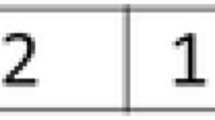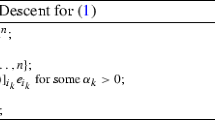Abstract
We examine efficient computer implementation of one method of deterministic global optimization, the cutting angle method. In this method the objective function is approximated from below with piecewise linear auxiliary functions. The sequence of global minima of these auxiliary functions converges to the global minimum of the objective function. Computing the minima of the auxiliary function is a combinatorial problem, and we show that it can be effectively parallelized. We discuss the improvements made to the serial implementation of the cutting angle method, and ways of distributing computations across multiple processors on parallel and cluster computers.
This research was supported by the Victorian Partnership for Advanced Computing, Australia
Access this chapter
Tax calculation will be finalised at checkout
Purchases are for personal use only
Preview
Unable to display preview. Download preview PDF.
Similar content being viewed by others
References
M. Andramonov, A. Rubinov and B. Glover, Cutting angle methods in global optimization, Applied Mathematics Letters, vol. 12 (1999), pp. 95–100.
A. Bagirov, Derivative-free methods for unconstrained nonsmooth optimization and its numerical analysis, Journal Investigacao Operational, vol. 19 (1999), pp. 75–93.
A. Bagirov and A. Rubinov, Global minimization of increasing positively homogeneous function over the unit simplex, Annals of Operations Research, vol. 98 (2000), pp. 171–187.
A. Bagirov and A. Rubinov, Modified versions of the cutting angle method, in N. Hadjisavvas and P. M. Pardalos, eds., Convex analysis and global optimization, Kluwer Academic Publishers, Dordrecht, 2001, pp. 245–268.
A. M. Bagirov and A. M. Rubinov, Cutting angle method and a local search, Journal of Global Optimization, to appear.
L. M. Batten and G. Beliakov, Fast algorithm for the cutting angle method of global optimization, Journal of Global Optimization, to appear.
I.M. Bomze and E. de Klerk, Solving standard quadratic optimization problems via linear, semidefinite and copositive programming. Journal of Global Optimization, to appear.
T. H. Cormen, C. E. Leiserson and R. L. Rivest, Introduction to algorithms, MIT Press, McGraw-Hill, Cambridge, Mass. New York, 1990.
C. A. Floudas, Deterministic global optimization: theory,methods,and applications, Kluwer Academic Publishers, Dordrecht, 2000.
R. Horst and H. Tuy, Global optimization: deterministic approaches, Springer-Verlag, Berlin; New York, 1993.
R. Horst and P. M. Pardalos, Handbook of global optimization, Kluwer Academic Publishers, Dordrecht; Boston, 1995.
J. L. Kiepeis, M. G. Ierapetritou and C. A. Floudas, Protein Folding and Peptide Docking - a Molecular Modeling and Global Optimization Approach, Computers and Chemical Engineering, vol. 22 (1998), pp. S 3–S 10.
F. T. Leighton, Introduction to parallel algorithms and architectures: arrays,trees,hypercubes, M. Kaufmann Publishers, San Mateo, Calif., 1992.
X. Liu, Finding global minima with a computable filled function, Journal of Global Optimization vol. 19(2001), pp. 151–161.
H. S. Morse,Practical parallel computing, AP Professional, Boston, 1994.
R. V. Pappu, R. K. Hart and J. W. Ponder, Analysis and application of potential energy smoothing and search methods for global optimization, Journal of Physical Chemistry B, vol. 102 (1998), pp. 9725–9742.
P. M. Pardalos and C. A. Floudas, Optimization in computational chemistry and molecular biology: local and global approaches, Kluwer Academic Publishers, Boston, 2000.
J. Pintér, Global optimization in action: continuous and Lipschitz optimization–algorithms, implementations, and applications, Kluwer Academic Publishers, Dordrecht; Boston, 1996.
A. M. Rubinov, Abstract convexity and global optimization,Kluwer Academic Publishers, Dordrecht; Boston, 2000.
T. Takaoka, Theory of Trinomial Heaps, in D.-Z. Du, P. Eades, V. Estivill-Castro, X. Lin and A. Sharma, eds., Computing and Combinatorics, Springer, Sydney, 2000, pp. 362–372.
A. Törn and A. Zhilinskas, Global optimization, Springer-Verlag, Berlin; New York, 1989.
B. Wilkinson and C. M. Allen, Parallel programming: techniques and applications using networked workstations and parallel computers, Prentice Hall, Upper Saddle River, N.J., 1999.
Author information
Authors and Affiliations
Editor information
Editors and Affiliations
Rights and permissions
Copyright information
© 2003 Kluwer Academic Publishers B.V.
About this chapter
Cite this chapter
Beliakov, G., Ting, K.M., Murshed, M., Rubinov, A., Bertoli, M. (2003). Efficient Serial and Parallel Implementations of the Cutting Angle Method. In: Di Pillo, G., Murli, A. (eds) High Performance Algorithms and Software for Nonlinear Optimization. Applied Optimization, vol 82. Springer, Boston, MA. https://doi.org/10.1007/978-1-4613-0241-4_3
Download citation
DOI: https://doi.org/10.1007/978-1-4613-0241-4_3
Publisher Name: Springer, Boston, MA
Print ISBN: 978-1-4613-7956-0
Online ISBN: 978-1-4613-0241-4
eBook Packages: Springer Book Archive




